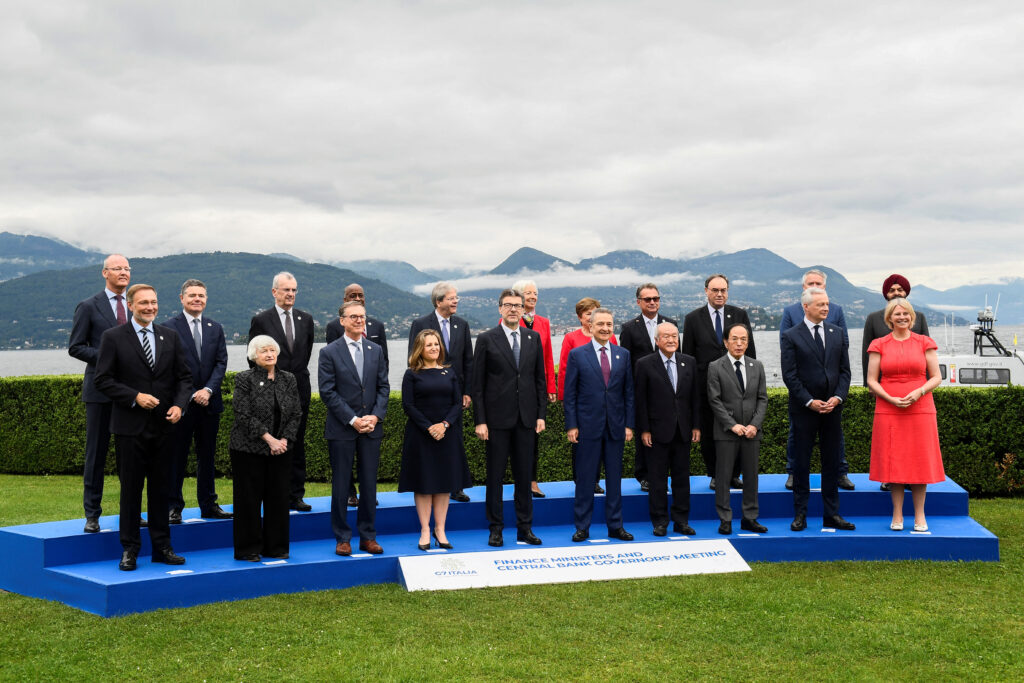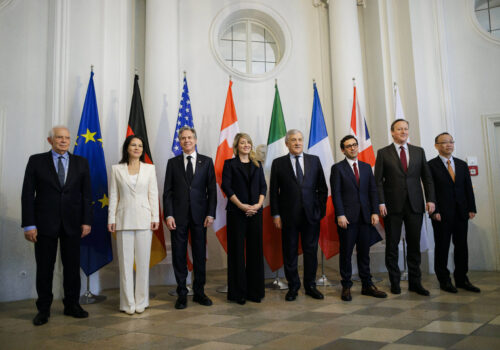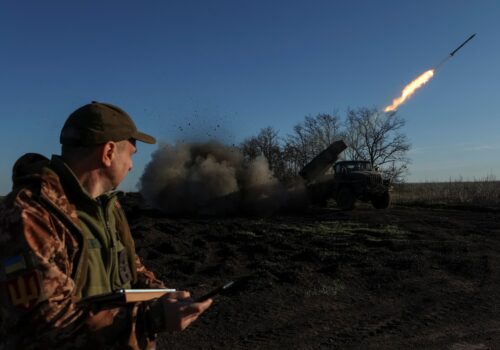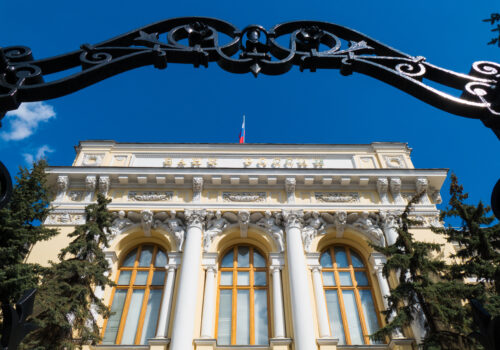Interest in the interest is growing. Over the past three days, Group of Seven (G7) finance ministers met in Stresa, Italy, on the shore of Lake Maggiore, to discuss what to do with a major pile of money. Following Russia’s full-scale invasion of Ukraine in 2022, G7 nations blocked around $300 billion in Russian assets in the West, the bulk of which are in Belgium, France, and Germany. Today, G7 finance ministers said they are making “progress” on a plan to use future interest generated by the assets to issue a loan to Ukraine. Reports say this loan could be as large as fifty billion dollars, and it could move forward as soon as the June 13-15 G7 leaders’ summit in southeastern Italy. Below, Atlantic Council experts follow the money.
Click to jump to an expert analysis:
Charles Lichfield: Past the point of no return on a sovereign loan to Ukraine
Daniel Fried: Take the best deal available now and keep pushing for the rest
Olga Khakova: Money generated by Russian assets can help save Ukraine from freezing this winter
John Herbst: The US is helpfully taking the lead on the sticky Russian asset problem
Past the point of no return on a sovereign loan to Ukraine
The G7 finance ministers’ statement isn’t as noncommittal as it sounds. It now privileges one approach to mobilizing Russia’s immobilized sovereign assets for Ukraine: bringing forward the value of interest income through a giant sovereign loan, worth more than half of Ukraine’s total expenditure this year.
Earlier this year, Germany, Italy, and France (the members of the G7 that use the euro), along with Japan, stood up to pressure from the United States and other countries to consider directly seizing the assets. It is a very significant achievement that—in a relatively short amount of time—the seven have converged around an approach that delivers a very large sum without crossing anyone’s red lines.
Given the speed at which the Europeans have swung behind the proposal, it’s safe to interpret that there is goodwill on all sides to resolve the outstanding technical details. The European Union (EU) sanctions legislation that keeps the assets blocked has to be renewed by consensus every six months. The European Council is unlikely to change this to an “unless-and-until” provision, although it has committed politically to keeping the assets blocked until Russia leaves Ukraine and pays compensation. The solution is for all sides to shoulder a share of the financial risk, and it appears the United States is willing to do so too.
We should expect more progress at the G7 leaders’ summit on June 13 and 14 in southeastern Italy. It may take a few months following that for the money to start flowing, but the G7 is clearly past the point of no return on this very constructive approach.
—Charles Lichfield is the deputy director and C. Boyden Gray senior fellow of the Atlantic Council’s GeoEconomics Center.
Take the best deal available now and keep pushing for the rest
The G7 seems to be closing in on a deal to use a substantial amount of Russian money to pay for Russia’s war of national destruction against Ukraine. Though not enough, it’s a big step and needs to be nailed down fast.
Almost immediately after Russia’s full-scale invasion of Ukraine in February 2022, the G7, working fast and in stealth, immobilized close to $300 billion of Russian sovereign assets. The G7 has since considered whether and, if so, how that money could be used to benefit Ukraine. After months of deliberation and indecision, G7 finance ministers seem to be drawing close to a consensus about using twenty years’ worth of interest on the immobilized assets, which could amount to about fifty billion dollars, as collateral for a loan (possibly no interest and forgivable) to Ukraine.
Many experts (such as former US diplomat Philip Zelikow) have made a strong case for using all of the Russian assets for Ukraine. But European resistance (especially from Germany and France) has held up agreement for months, while Ukraine’s needs have grown more urgent. Biden administration officials decided to push for the best deal at hand—the fifty-billion-dollar deal. In their place, I would have done the same: Take what you can get now and keep pushing for the rest.
Moving forward with this deal would be welcome. But the delay in advancing toward a decision—and the limited nature of the tentative deal—illustrates a problem: Russia is an aggressive and dangerous nation waging war against one neighbor, threatening others, and trying to intimidate Europe into allowing the Kremlin to reassemble the Russian Empire through violence. Peacetime norms must give way to norms suited to the harsher era that is upon us, whether we like it or not. Those European opponents of using Russia’s assets to pay for Russia’s war of aggression should reconsider. Today’s announcement of progress is not yet a step commensurate with what is required.
—Daniel Fried is the Weiser Family distinguished fellow at the Atlantic Council, former US ambassador to Poland, and former US assistant secretary of state for Europe.
Money generated by Russian assets can help save Ukraine from freezing this winter
While the West is debating the feasibility of confiscating Russian frozen assets, Ukraine needs a massive influx of funds now to prepare its energy system for a brutal winter ahead, minimize debilitating blackouts this summer, and defend the remaining infrastructure from Russian bombardment. The energy sector has been a prime target of Moscow’s genocidal campaign, and these strategic attacks have intensified this spring, with a focus on central energy generation—the largest thermal power plants providing Ukrainians with essential services and keeping industry and business running despite the war.
Before the G7 finance ministers met in Stresa, the EU agreed in principle to a fifty-billion-dollar bond proposal for the blocked assets, of which up to 90 percent would be earmarked for arms and military equipment. On the surface, this may appear irrelevant to the urgent needs in the energy sector, but it’s the most effective investment for keeping the remaining energy system protected and enabling reconstruction and repairs of lifesaving infrastructure. The remaining 10 percent would go to budgetary and humanitarian support under the EU facility and can contribute toward procuring gas turbines and other equipment. This money, which could begin to arrive as early as July if G7 leaders finalize a deal next month, could also help alleviate the additional expense of having to import electricity from Ukraine’s European neighbors, which would have been generated at a fraction of the price by Ukraine’s now-destroyed power plants.
Fifty billion dollars is nowhere close to the cost of Russia’s unprovoked horror and misery on Ukrainian citizens, the natural environment, critical infrastructure, and culture. However, channeling these windfall profits from the immobilized Russian assets toward Ukraine’s most dire needs is a small but decisive step toward setting the precedent that Russia will not escape from paying for its crimes. Moreover, as appropriation of the money changes to reflect Ukraine’s priorities, a significant percentage of profits could be directed toward reconstruction efforts.
—Olga Khakova is the deputy director for European energy security at the Atlantic Council’s Global Energy Center.
The US is helpfully taking the lead on the sticky Russian asset problem
No white smoke emerged from the meeting of G7 finance ministers in Stresa, Italy, this week in their preparations for the G7 Summit next month. The key issue on their agenda was how to deal effectively on the financial side with the greatest current threat to global security and prosperity: Vladimir Putin’s determination to dominate Ukraine. The ministerial took small, sensible steps regarding additional sanctions on Russia in, for instance, the energy area. But the big item was, of course, the roughly $300 billion in Russian state assets frozen in the international financial system. The EU took a baby step recently, allowing the use of dividends from those assets to be transferred to Ukraine. That might provide Ukraine a few billion dollars a year.
But to its credit, with White House Deputy National Security Advisor for International Economics Daleep Singh leading the charge, the United States for months has been looking for a more ambitious approach: to bundle multiple years of interest payments to allow a payment of fifty billion dollars up front. US Treasury Secretary Janet Yellen put her shoulder to this wheel in Stresa, and reports suggest that she made some progress.
With three weeks to the G7 Summit, there is time to get this deal done. But while Canada and the United Kingdom are interested in the US proposal, the rest of the G7 members are concerned about possible Russian retaliation, and there has also been unhelpful lobbying from China and Saudi Arabia against transferring the assets to Ukraine. So success at the Italy summit cannot be taken for granted. But it is good to see the United States in the lead on a key issue related to the war and, if US President Joe Biden and Yellen deliver the goods in Apulia, the United States can then take up the proposal pushed brilliantly by Philip Zelikow, Bob Zoellick, and Larry Summers to come back for the remaining $250 billion in Russian state assets.
—John E. Herbst is the senior director of the Atlantic Council’s Eurasia Center and a former US ambassador to Ukraine.
Further reading
Fri, Feb 23, 2024
Russia’s blocked assets: A ‘non-collateral collateral’ plan could be the way forward
New Atlanticist By Charles Lichfield
Instead of seizing Russia’s immobilized sovereign assets outright, G7 members seem instead to be aligning around “unlocking their value.”
Sat, Apr 20, 2024
Renewed US assistance opens a path to success, if Ukraine’s friends move fast
New Atlanticist By Daniel Fried
The delay in US aid was deadly for Ukraine and damaging to US credibility. Now that aid is likely on its way, what's needed next to help Ukraine fend off an expected Russian land offensive?
Thu, May 2, 2024
Understanding the plan to create a $50 billion Ukraine bond from Russia’s blocked assets
Econographics By Charles Lichfield, Mrugank Bhusari
The United States is pushing the G7 to consider a sovereign loan of $50 billion to Ukraine which would be repaid using the interest income on blocked Russian assets. Where does this $50 billion figure come from?
Image: German Finance Minister Christian Lindner, United States Secretary of the Treasury Janet Yellen, Bank of Canada Governor Tiff Macklem, Canada's Minister of Finance Chrystia Freeland, Italy's Economy Minister Giancarlo Giorgetti, Bank of Italy Governor Fabio Panetta, Japan's Finance Minister Shunichi Suzuki, Bank of Japan Governor Kazuo Ueda, France's Minister for Economy and Finances Bruno Le Maire, Eurogroup President Paschal Donohoe, Bank of France Governor Francois Villeroy de Galhau, European Central Bank (ECB) President Christine Lagarde, International Monetary Fund (IMF) Managing Director Kristalina Georgieva, President of Germany's Federal Reserve Bundesbank Joachim Nagel, World Bank President Ajay Banga, attend a family photo session at the G7 Finance Ministers and Central Bank Governors' meeting in Stresa, Italy, May 24, 2024. REUTERS/Massimo Pinca/File Photo



